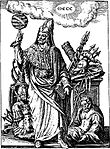begin quote from:
Rosicrucianism
(Redirected from Rosicrucian)
| Part of a series on |
| Hermeticism |
|---|
 |
| Mythology |
| Hermetica |
"Three Parts of the Wisdom of the Whole Universe"
|
| Movements |
| Orders |
| Topics |
| People |
Rosicrucianism is a spiritual and cultural movement which arose in Europe in the early 17th century after the publication of several texts which purported to announce the existence of a hitherto unknown esoteric order to the world and made seeking its knowledge attractive to many.[1][2] The mysterious doctrine of the order is "built on esoteric truths of the ancient past", which "concealed from the average man, provide insight into nature, the physical universe, and the spiritual realm."[3] The manifestos do not elaborate extensively on the matter, but clearly combine references to Kabbalah, Hermeticism, alchemy, and Christian mysticism.[4]
The Rosicrucian manifestos heralded a "universal reformation of mankind", through a science allegedly kept secret for decades until the intellectual climate might receive it. Controversies arose on whether they were a hoax, whether the "Order of the Rosy Cross" existed as described in the manifestos, and whether the whole thing was a metaphor disguising a movement that really existed, but in a different form. In 1616, Johann Valentin Andreae famously designated it as a "ludibrium". Some scholars of esotericism suggest that this statement was later made by Andreae in order to shield himself from the wrath of the religious and political institutions of the day, which were intolerant of free speech and the idea of a "universal reformation", which the manifestos called for.
An example of the rosicrucian rosy cross symbol predating the early rosicrucian manifestoes is that shown on the central panel of the Harbaville Triptych, which is Byzantine and comes from the 10th or 11th century. The symbol is a Calvary cross with a rose in its centre, which is identical with what the masonic/rosicrucian scholar Manly Palmer Hall claimed to be the original symbol of the rosicrucians.
In his work "Silentium Post Clamores" (1617), the rosicrucian Michel Maier (1568–1622) described rosicrucianism as having arisen from a "Primordial Tradition" in the following statement: "Our origins are Egyptian, Brahmanic, derived from the mysteries of Eleusis and Samothrace, the Magi of Persia, the Pythagoreans, and the Arabs."
By promising a spiritual transformation at a time of great turmoil, the manifestos influenced many figures to seek esoteric knowledge. Seventeenth-century occult philosophers such as Michael Maier, Robert Fludd, and Thomas Vaughan interested themselves in the Rosicrucian world view.[1] According to the historian David Stevenson, it was influential on Freemasonry as it was emerging in Scotland.[5]
In later centuries, many esoteric societies have claimed to derive from the original Rosicrucians. Rosicrucianism is symbolized by the Rosy Cross or Rose Cross. The largest and most influential of these societies has been the Hermetic Order of the Golden Dawn, which consisted of several well known members of society. The other is the Rosicrucian Order, A.M.O.R.C, an international, initiatic Fraternity, which involves itself in several educational and cultural activities worldwide.

No comments:
Post a Comment